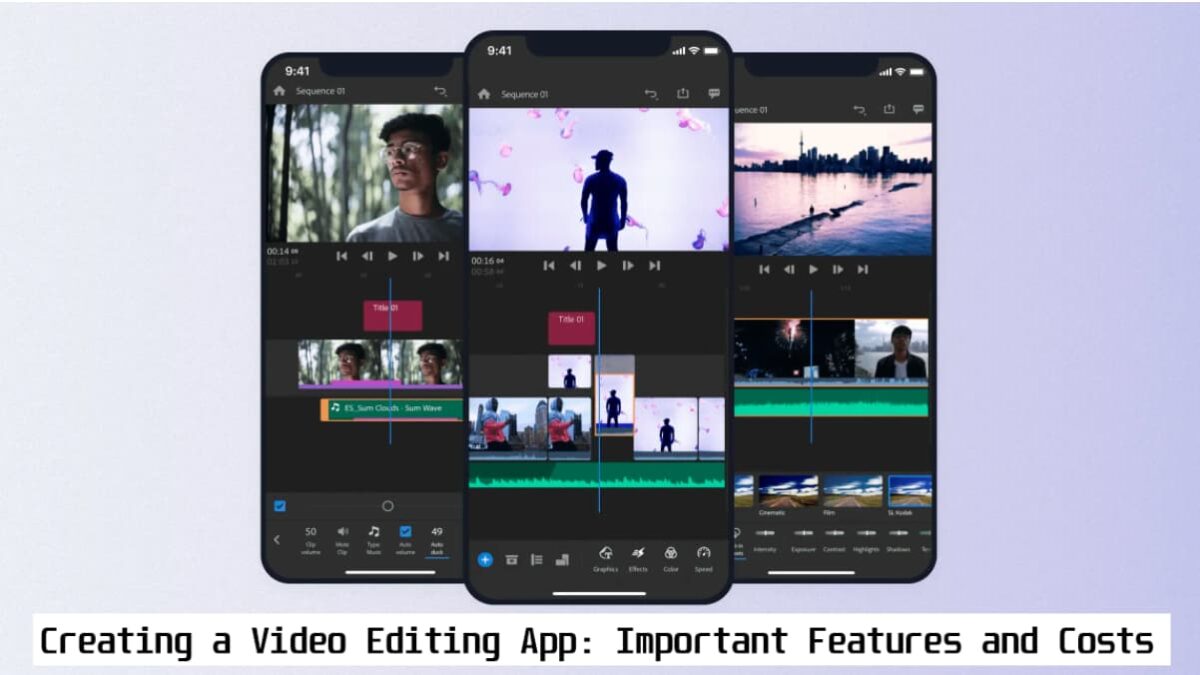Today’s digital world is dominated by video content. The boom in mobile video traffic highlights the importance of good video editing apps for creating content. These applications allow users to make professional videos from their handsets, hence meeting the rising need for more stimulating visual material.
Different Types and Costs of Video Editing Apps
The price of making a video editing application can differ significantly due to its attributes, intricacy and the platforms it supports. Generally, you could spend between $30,000 and $300,000 on just creating it. There are five main types of video apps, each being used for different purposes:
- Video Recording Apps: Concentrate on producing high-quality videos.
- Video Editing Apps: Offer options for trimming, merging clips and improving them.
- Combined Recording and Editing Apps: These offer both recording and editing features.
- Screen Recording Apps: allow individuals to capture their screen on a device.
- Apps Combining Screen Recording and Editing: Where one records their footage at the same time as they edit it using the app itself.
This variety on the market consists of applications meant for basic recording purposes only, up to those designed with advanced editing capabilities and screen-capturing mechanisms too.
Popular Video Editing Apps
When designing an app, conducting market analysis is essential. Understanding competitors and the market they serve can be done by looking at popular video editing apps. The following are four highly recognized video editing applications:
Adobe Premiere Rush
Adobe Premiere Rush serves both professionals and amateurs using iOS, Android, and desktops. It has an in-built video recording feature, drag-and-drop editing ability, the ability to insert music or effects, as well as seamless social media connectivity. Adobe Cloud storage is available to users, allowing them to work with ease on any device. At $9.99 per month, one can subscribe to Splice, which offers strong editing tools along with cloud services.
Quik by GoPro
The company’s Quik app enables it to advertise its brand while being compatible with GoPro cameras. Key features include automatic video analysis, customizable titles and adjustable templates. It is free and works on both Android and iOS devices, thus making it reach a wide audience.
Splice
This application allows iOS users to perform different kinds of video edits that may involve the addition of texts, transitions, and music tracks, among others. Furthermore, it blends smoothly with the iTunes library for audio file importation through various options, like adding any song from the iTunes store free of charge or even using My Music section to pick songs already saved in your phone’s memory. The package comes with a subscription version that costs $9.99 every month, providing robust editing capabilities suitable for beginners as well as advanced users alike.
iMovie
iMovie is a free Apple app that provides several features, such as Hollywood-like trailers, templates, themes and 4K resolution support. It’s compatible with iOS and macOS. Hence, projects can be easily moved from one Apple device to another, making it the preferred choice of many Apple users.
Key Steps in Developing a Video Editing App
The creation of any video editing app involves careful planning and decision-making. The following are the most important steps:
Refining Your App Idea
To identify gaps and opportunities in the market, competitor research is crucial. Understanding what existing applications do well or not is important in creating an innovative solution that meets consumers’ needs.
Understanding Your Target Audience
Understanding who your target audience is paramount. Segment the audience by age groups, locations, interests or income ranges, among others. Get direct input from real users through a platform like Quora, or engage experienced software vendors to get a better view of what the market needs to develop.
Defining Essential Features
Define the essential features of your app, focusing on both the minimum viable product (MVP) and additional features. Must-have MVP features include trimming, merging files, adding music, colour correction, social sharing, and saving/loading videos. Advanced features might include syncing with music services, cloud storage, speed adjustments, and AI editing assistance.
Choosing the Right Monetization Strategy
Selecting a monetization model early in its development is crucial. Common models include in-app advertising, freemium, subscription, and premium. For example, Adobe Premiere Rush uses a subscription model, while Quick is free with potential in-app purchases. Consulting business analysts or conducting A/B testing can help determine the best strategy for your app.
Technical Challenges in Developing Video Editing Apps
Developing a video editing app involves overcoming various technical challenges, divided into Android and iOS development.
Challenges in Android Development
Android-specific challenges include video rendering speed, missing features in pre-made solutions, and implementing filters. Tools like FFmpeg and Transcoder can help, each with its pros and cons.
Challenges in iOS Development
iOS-specific challenges involve managing video and image orientation, precise merging of videos with pictures, and correctly adding audio tracks. Pixel accuracy and managing scalable audio volumes are critical for maintaining high-quality outputs.
Recommended Tech Stack for iOS and Android
Developing video editing apps requires a robust tech stack. Here are some recommended technologies:
- Login and Authentication: Firebase
- Video Trimming and Editing: FFmpeg
- Social Network Sharing: Various SDKs (e.g., Facebook, Twitter)
- Cloud Storage: Amazon S3 or Google Cloud Storage
- User Interface: React Native or Flutter for cross-platform development
In conclusion, creating a video editing app involves careful planning, understanding market needs, and addressing technical challenges.
